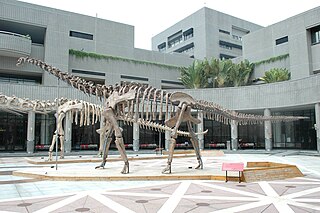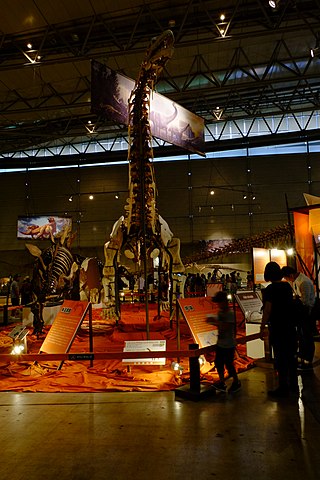Borealosaurus is a genus of titanosaurian sauropod dinosaur from the Late Cretaceous of northern China. The type species is Borealosaurus wimani, which was named in 2004.

Sonidosaurus is a genus of sauropod dinosaur from the Late Cretaceous. It was a titanosaur which lived in what is now Inner Mongolia. The type species, Sonidosaurus saihangaobiensis, was described by Xu, Zhang, Tan, Zhao, and Tan in 2006. It was a small titanosaur, about 9 meters (30 ft) long. It was first discovered in the Saihangaobi, Iren Dabasu (Erlian) Formation, in 2001 in a quarry which would later yield the remains of Gigantoraptor.

Huanghetitan, is a genus of sauropod dinosaur from the early Cretaceous Period. It was a basal titanosauriform which lived in what is now Gansu, China.

Zhongyuansaurus is a monospecific genus of ankylosaurid dinosaur from Henan that lived during the Early Cretaceous in what is now the Haoling Formation. Zhongyuansaurus is possibly a junior synonym of Gobisaurus, a basal ankylosaurid from the Ulansuhai Formation of Inner Mongolia.

Luanchuanraptor is a genus of dromaeosaurid theropod dinosaurs from the Late Cretaceous of China. The genus is based on a partial skeleton from the Qiupa Formation in Luanchuan, Henan. They were medium-sized dromaeosaurids, the first Asian dromaeosaurid taxa described from outside the Gobi Desert or northeastern China.
Paleontology or palaeontology is the study of prehistoric life forms on Earth through the examination of plant and animal fossils. This includes the study of body fossils, tracks (ichnites), burrows, cast-off parts, fossilised feces (coprolites), palynomorphs and chemical residues. Because humans have encountered fossils for millennia, paleontology has a long history both before and after becoming formalized as a science. This article records significant discoveries and events related to paleontology that occurred or were published in the year 2007.

Ruyangosaurus is a genus of titanosauriform sauropod dinosaur recovered from the Early Cretaceous Haoling Formation of China. The type species is R. giganteus, described in 2009 by Lü Junchang et al.

The Yixian Formation is a geological formation in Jinzhou, Liaoning, People's Republic of China, that spans about 1.6 million years during the early Cretaceous period. It is known for its fossils, listed below.
The Xiaguan Formation is a Turonian to Campanian geologic formation in Henan Province of China. Dinosaur remains are among the fossils that have been recovered from the formation.
The Haoling Formation is a Mesozoic geologic formation in the Ruyang Basin of Henan, Province, central China. Dinosaur remains are among the fossils that have been recovered from the formation.

The Gaogou Formation is a fossiliferous geological formation located in the Xixia Basin of China. The formation dates back to the Late Cretaceous (Cenomanian-Coniacian) and fossilized eggs of dinosaurs and turtles are commonly reported from the formation. Dinosaur taxa is also reported from the unit.

Xianshanosaurus is a genus of sauropod dinosaur from the Early Cretaceous (Aptian-Albian) of the Ruyang Basin in Henan Province, China. Its type and only species is Xianshanosaurus shijiagouensis. It was described in 2009 by a team of paleontologists led by Lü Junchang. Xianshanosaurus may be a titanosaur, and Daxiatitan may be its closest relative, but its evolutionary relationships remain controversial.
The Nanxiong Formation is a Late Cretaceous geologic formation in Guangdong Province. Dinosaur remains are among the fossils that have been recovered from the formation.

The Qiupa Formation is a Late Cretaceous Maastrichtian geologic formation in Henan Province, central China. It is rich in dinosaur eggs and bones, such as those of carnivorous and herbivorous dinosaurs. The Qiupa Formation is considered to be Late Maastrichtian in age, about 72 million and 66 million years ago.
Yunmenglong is an extinct genus of somphospondylan sauropod known from the late Early Cretaceous of Henan Province, central China. Its remains were discovered in the Haoling Formation of the Ruyang Basin. The type species is Yunmenglong ruyangensis, described in 2013 by Junchang Lü et al. on the basis of an incomplete postcranial skeleton. Yunmenglong shares some characters with Euhelopus, Qiaowanlong and Erketu, and a phylogenetic analysis places it as a sister taxon of Qiaowanlong, both grouped with Erketu in a position more derived than Euhelopus but basal to Titanosauria.
The year 2011 in Archosaur paleontology was eventful. Archosaurs include the only living dinosaur group — birds — and the reptile crocodilians, plus all extinct dinosaurs, extinct crocodilian relatives, and pterosaurs. Archosaur palaeontology is the scientific study of those animals, especially as they existed before the Holocene Epoch began about 11,700 years ago. The year 2011 in paleontology included various significant developments regarding archosaurs.
The year 2009 in Archosaur paleontology was eventful. Archosaurs include the only living dinosaur group — birds — and the reptile crocodilians, plus all extinct dinosaurs, extinct crocodilian relatives, and pterosaurs. Archosaur paleontology is the scientific study of those animals, especially as they existed before the Holocene Epoch began about 11,700 years ago. The year 2009 in paleontology included various significant developments regarding archosaurs.





















